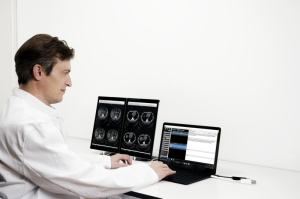How remote/mobile reading will be part of the future in radiology
October 16, 2018

By Trevor Bromley
When “phoning it in” is a good thing: remote reading in radiology
The pace of technological advancement continues to accelerate. Rather than each new discovery reducing the ability to find the next big thing, it is leading the way. Consider this timeline of years relevant to teleradiology: 1876, 1895, c. 1930, 1971, 1973, 1983 and 1993. Those years correspond respectively to the first telephone call, the first X-ray, the first official accounts of telemedicine (done by radio to and from the ship The Queen Mary), the first email sent over the precursor to the Internet, the first mobile phone call made, the adoption of the DICOM standard, and the introduction of the modern DICOM systems.
The power of telemedicine
Sprinkled throughout that list of years were numerous advancements, but it’s only been in the last few decades that the power of telemedicine and more specifically, teleradiology, has gotten its due. The early history required the dedication and faith of visionaries with the strength to stand against detractors until the medical community recognized the potential. It required the perfect storm of technology, financial interest, medical know-how and forward-thinking legislation and regulation. It also required open minds and an understanding that “never” is a word that should seldom be used when talking about the potential benefits technology might deliver.
For instance, less than a decade ago, many healthcare technology experts anticipated that FDA approval of mobile devices for readings would be many years in the future (if ever). To be fair, the resolution mobile devices provided at the time was not on par with what one would find in a hospital. Today though, the technology held in the palm of one’s hand surpasses the capabilities of that found in some healthcare settings in the early '90s, and readily available mobile devices are nearly at the point that the images they’re providing are as detailed as what the naked eye can discern.
Regulators are realizing this and are finally embracing the potential of mobile devices in regard to teleradiology. As a case in point, EBM Technologies, which received FDA approval for the use of its software paired with the iPad Pro for all reading except mammography. The technology is here, and it is being deployed in the field.
The implications of mobile reading:
Addressing costs
So what does the evolution of mobile reading mean? According to William Pan, founder and CEO of EBM Technologies, “I don’t think it’s an overstatement to say it will revolutionize medicine. With healthcare costs continuing to rise at unsustainable levels, any cost-curbing opportunities are welcome, and remote reading does have the potential to reduce costs.” Remote reading using an iPad Pro is a fine-tuning of cost reductions. Consider the investment a hospital would need to make for a traditional medical-level display – in the area of $4,000 and up. An iPad Pro, which is about one-fifth the cost at $800 and EBM’s Rad@ software is $1,200. So for $1,800 they can provide FDA-approved, medical-level displays for remotely reading everything except mammography at this time. This is to say nothing of facility space requirements for larger reading stations and the physicians that also occupy that space. These costs must also be factored into the equation.
|
|
|
You Must Be Logged In To Post A Comment
|
